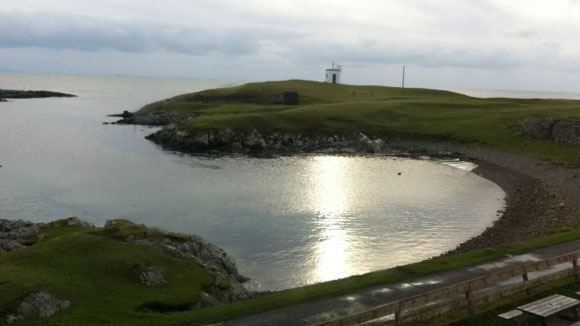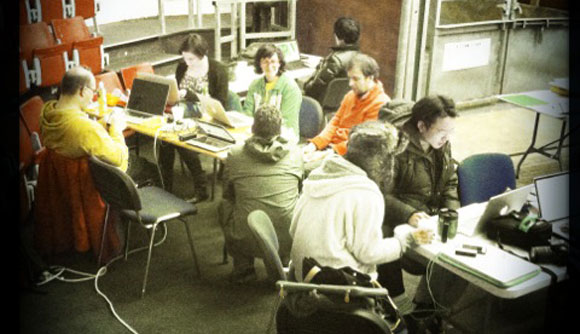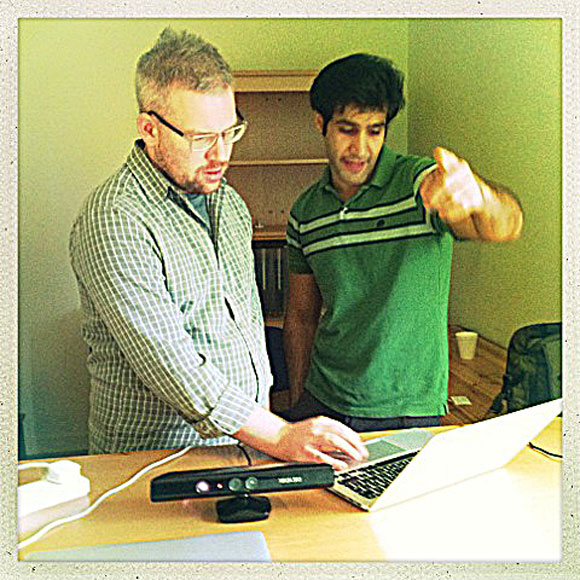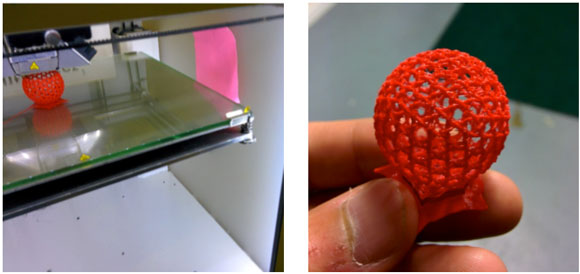

Photo courtesy Adam van Sertima.
A legendary locale for windsurfing, the small Isle of Tiree in Scotland, UK is gaining recognition as a venue for those exploring the digital wave. The eighth Tiree Tech Wave (October 23-27, 2014) brought together an eclectic mix of participants to consider the social and philosophical challenges of technology by engaging directly with it. These hands-on, unstructured workshops involve experimentation and play with computer hardware, software, and open data, fostering dialogue and collaboration on contemporary issues in digital culture. This year, GRAND supported the involvement of two Canadian PhD students: Adam Van Sertima (Concordia University) and Mohamad Salimian (Dalhousie University).
Report by Adam Van Sertima (@adamvs1)
This article was originally posted on the TAG Centre website.

Adam Van Sertima (left) is a doctoral researcher at Concordia University's TAG Centre. Photo courtesy Adam van Sertima.
The island of Tiree with its sheep, wind surfing, and limited physical connection to the mainland seems like an unlikely place for a 'tech' conference. TechWave's vision is to consider the social and philosophical challenges of technology by engaging directly with it but without specific objectives. Alan Dix, a mathematician & computer scientist founded the Tiree TechWave workshop. One theme that does recur in the workshop is the place of technology in peripheral, marginal, or disavantaged situations. The relative remoteness of Tiree, situated in the Inner Hebrides emphasises the specificities of deploying hi-tech in a given environment. I attended the 8th TechWave (Oct 23-27 2014) and was able to discuss my dissertation and gain valuable insights into the questions of theories of mind.
A group of Fellows from the UK-based innovation Charity NESTA worked on developing an AI application that predicted whether the weather would distrupt the sailing of the ferry that is the island's life-line to the UK mainland at the port of Oban. I was priveleged to participate in their discussions and made a small contribution to their conceptualisation of the problem. This transdisciplinary approach is part of what makes these workshops so compelling. They don't stand on disciplinary ceremony, but encourage a sharing of ideas and methods from the participants.

Part of this sharing is based on a policy of no specific outcomes. The argument for this is that by avoiding preconceived goals, this "open agenda does lead to remarkable things happening". A kinect and arduino arrived in my bags but they were tools I offered, rather than part of a pre-conceived project. In the end I worked with David Morrison, a NESTA Fellow and graduate of Abertay University's degree in computer games technology, and Mohamad Salimian, a PhD student and GRAND HQP from the Computer Science department of Dalhousie University. We worked together on getting David's art game, based on a kinect-based body movement pachinko machine off the ground. Both David and Moh worked on other projects. The workshop offered a chance to start projects that could be further developed.
Equally interesting were the conversations where ideas were explored with a view to future development. Stephen Forshaw, a PhD in the High Wire program at Lancaster University http://highwire.lancs.ac.uk/ critiques the "linearity" of education in the face of an icreasingly non-linear society. http://lancaster.academia.edu/StephenForshaw
He argues for social systems where the individual moves freely rather than having a fixed staus and role. Foresham argues modern tech can facilitate this social fluidity, IF it is designed that way. He says "I think by making, playing and doing" which has a resonance with my dissertation work.
A chat with Alan Dix raised a new question about the theoretical basis of my research: rather than assuming that theories of mind begin with an individual assuming that their experience is mirrored in others, Dix suggests that we learn to think about our own minds by watching others as that who acts. This is highly relevant to investigating phenomenological theories that explore child development, and hence to how we come to understand ourselves and others as agents.
I also discussed the value of qualitative research with Bethany Gordon, a doctoral student in the Design Science program at Cardiff Metropolitan university. The debate arose from the problem of trying to quantify user experience, and the value of using qualitative methods to better conceptualize hypothesizes for subsequent quantitative research.
A group of students sponsored by Samsung attended along with their colleagues from the School of Design at Cardiff Metropolitan University. Andrew Sage, another NESTA Fellow, brought his board game Sheepy Sleepy. It included 3-D printed sheep. No sheep were scanned for this project.
My take-aways- I would jump at the chance to go to future TechWaves. This is a great environment to share, explore and develop ideas. You will make things you did not anticipate, and possibly develop a deeper habit of creativity. I very grateful for GRAND NCE, the TAG research Center and Prof. Lynn Hughes for encouraging and funding me to go.
Report by Mohamad Salimian

Mohamed Salimian (right) is a doctoral Computer Science student at Dalhousie University. Photo courtesy of Mohamad Salimian.
Describe one highlight of Tiree Tech Wave 8
When I traveled to beautiful Tiree Island for the workshop, I had no idea what I was supposed to work on and that made me more excited. The first thing that caught my eyes at the workshop was a big table with a pile of different hardware tools on it such as Arduino kits, heat and sound sensors, Asus Xtion PROs, LEDs, painting tools, Microsoft Kinects and raspberry pies. Also there were three 3D printers and a laser cutter machine around the room. Professor Dix, the workshop coordinator, started the workshop with short introduction and asked everyone to talk to other participants for an hour to break the ice between them. I learned that participants at the workshop had different educational and backgrounds such as computer science, management, environment, music, art, philosophy and microbiology. We had researchers, students and people who were employee of different companies. The Tiree tech was an open workshop, and it did not have a specific theme. After Professor Dix explained each hardware tool, he encouraged us to define an arbitrary project and work on it during the next days. That was an amazing and unique opportunity to learn and expand my skills. I had people with different skills, knowledge and background around myself and also wide range of hardware tools and technologies. I had experience in using Microsoft Kinect and Arduino kits. I had never used 3D printer, so I decided to work on a small project to learn how to design and print a 3D object. Also Adam, my friend from Concordia university, and I were involved ourselves in another two projects. One was a project to capture information form the room using the heat and voice sensors and then visualize them on a website. Another project was to use Microsoft Kinect to recognize people’s gestures and movements and map different music tones to their gestures. Finally we would visualize them in an interactive way by using the processing language.

Experimenting with 3D printing. Photo courtesy of Mohamad Salimian.
What impact will this have on your research? And what networking opportunities did you find most useful?
I am working on collaborative environment, and I am interested in body interaction technologies. In my recent project I investigated on natural methods for managing privacy in mixed presence environments. Professor Dix worked in these fields before and he had different papers and books chapter related to collaboration in mixed presence collaborative environments. I had a chance to discuss my project with him and ask for his advices and suggestions. Also I learned that some of the participants at the workshop worked on collaborative environment, and they were interested to learn more about my work. Stephen Forshaw from Lancaster University was one of the interesting person I had a chance to discuss my project with. He provided me a list of interesting papers for reading and also he connected me to several researchers who are working in this field.
This workshop gave a chance to me to think without any limitation and explore my interests in different areas. Working with people with different backgrounds helped me to think beyond my field of study and learn new skills. I believe thinking beyond our usual activities and field would definitely help us to be more creative.
Would you like to give kudos to a presenter or fellow researcher?
In parallel to the workshop, there were several lectures and tutorials to introduce new technologies. These lectures were open to both local people and workshop’s participants. I really enjoyed a lecture about introducing and using 3D scanner presented by Stephen Forshaw from Lancaster University. And another lecture about introducing and using 3D printer presented by Gareth Loudon’ group from Cardiff school of art and design.